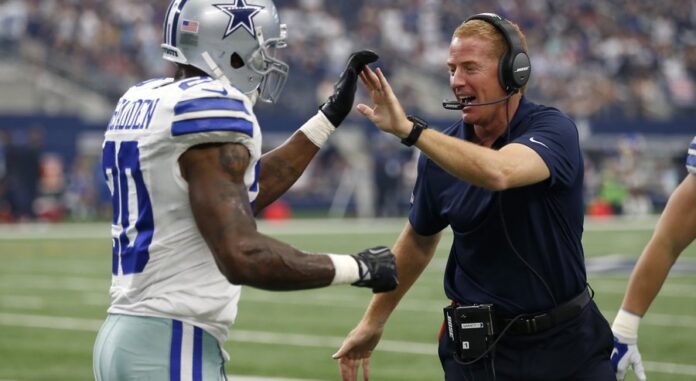Establishing the Run Game Best Chance for Dallas to Slow New England Offense
What’s the most effective strategy for staying dry? Avoid standing in the rain.
When preparing to face the Patriots, a crucial initial question is: How do we effectively counter Tom Brady and the Patriots’ offense?
It’s essential to recognize that completely ‘stopping’ them may not be a realistic goal.
Throughout history, teams have found it challenging to halt them; instead, they should focus on containing them.
In the Patriots’ recent game, the Jaguars initiated with a “go” route to WR Allen Robinson on the first play from scrimmage.
Unfortunately, it was incomplete, resulting in 2nd and long, then 3rd and long, and ultimately a punt.
Tom Brady gained possession of the ball almost as quickly as kernels popping in a bag of stadium popcorn.
Five plays later, the Patriots scored, setting the stage for an early game lead.
The task of overcoming the Patriots quickly turned into a formidable challenge within minutes.
It goes without saying that the Cowboys can ill-afford to replicate that scenario come Sunday.
Having played on both the Patriots and Jets, I’ve experienced both sides.
While your defense can have a standout performance, it’s more realistic to devise a schematic approach to limit their offensive output.
The most reliable way to prevent the Patriots’ offense from racking up a high score against the Cowboys is to minimize Tom Brady’s time with the ball.
The longer he has it, the more likely he will face difficulties.
GO BIG OR GO HOME
Upon reviewing the game tape, it should be evident to the Cowboys that each offensive snap must yield positive results.
Opting for deep passes early carries the risk of incompletions and short series.
On the contrary, the running game offers a more reliable source of positive plays.
In simple terms, the Cowboys must establish early success in their running game, or the game could slip away before the first daily fantasy commercial.
Both the Cowboys and the Patriots are aware of this crucial aspect. Therefore, a pivotal moment in the game will occur early when the Patriots unveil their defensive strategy for containing the Cowboys’ running attack.
In their matchup against the Steelers, the Patriots opted for a lighter defensive formation by employing nickel defense (substituting a linebacker with a defensive back) against Pittsburgh’s initial two-tight end, run-focused offensive sets.
Essentially, New England was willing to sacrifice a bit in the running game to prevent Big Ben from exploiting them through the air (as illustrated below).
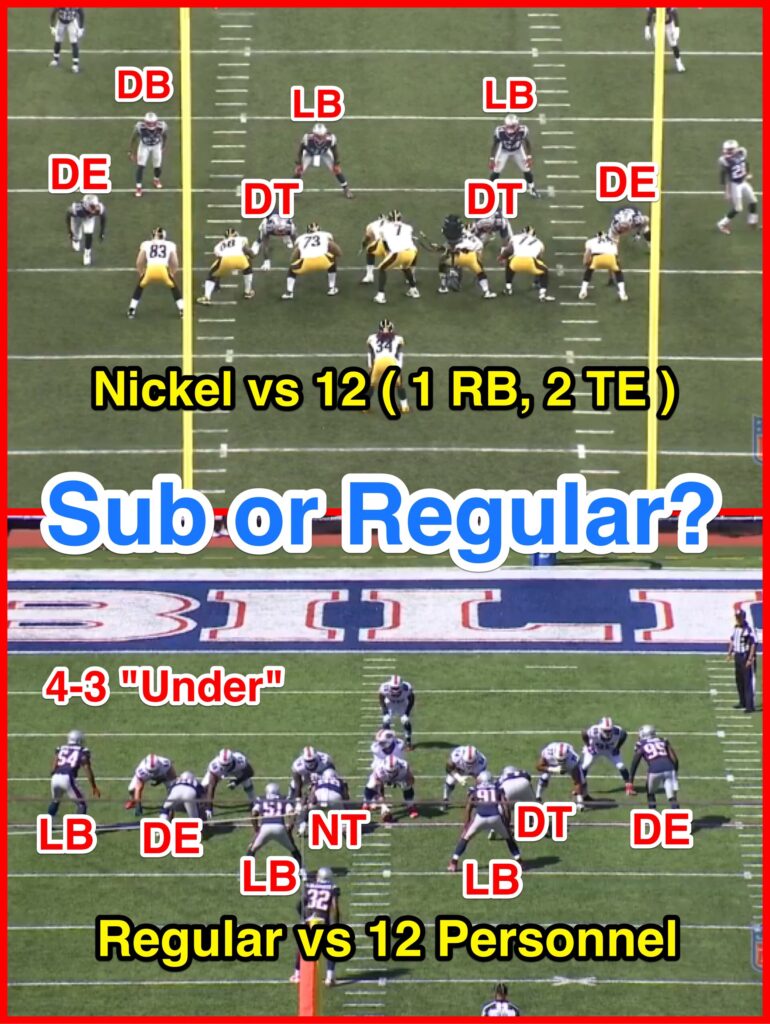
In the following week against the Buffalo Bills, the Patriots briefly showcased a conventional defensive setup with four defensive linemen and three linebackers, aiming to fortify the box against the running threat posed by quarterback Tyrod Taylor and running back LeSean McCoy.
However, they abandoned this formation swiftly as the game quickly swung in favor of the Patriots.
Instead, they predominantly deployed defensive sets featuring additional defensive backs as the Bills attempted to mount a comeback through the passing game.
Throughout the season thus far, the Patriots have leaned heavily towards using sub (nickel or dime) defense over the traditional defensive formation.
This tendency is mainly due to their propensity to secure early-game leads.
However, it’s unlikely they’ll be able to rely on this strategy against the Cowboys’ exceptionally skilled and physically imposing offensive line.
KNOWING IS HALF THE BATTLE
A significant unresolved concern for the Cowboys revolves around identifying the primary ball carrier if they opt for a ball-control strategy.
With RB Lance Dunbar sidelined for the season due to a torn ACL and reported coaching dissatisfaction with RB Joseph Randle following a perceived ball-handling lapse last week, the bulk of the responsibility will fall on RB Darren McFadden.
A crucial aspect for the Patriots is recognizing which running back is on the field and understanding the distinct strengths and ensuing plays associated with each player.
Randle fits the profile of what we call a “bounce-out, cutback runner.”
He often receives straightforward zone stretch plays, allowing him to select his lane.
If a cutback opportunity arises, he’s highly inclined to exploit it. Furthermore, he can execute a cutback that spans the entire width of the formation.
The Patriots’ backside defenders can almost consider themselves the focal point of attack on any running play involving Randle.
As Bill Belichick frequently emphasized, “Don’t fret. He’ll be there.”
Refer to the illustration below for a demonstration of Randle’s proficiency in executing extensive cutback runs.
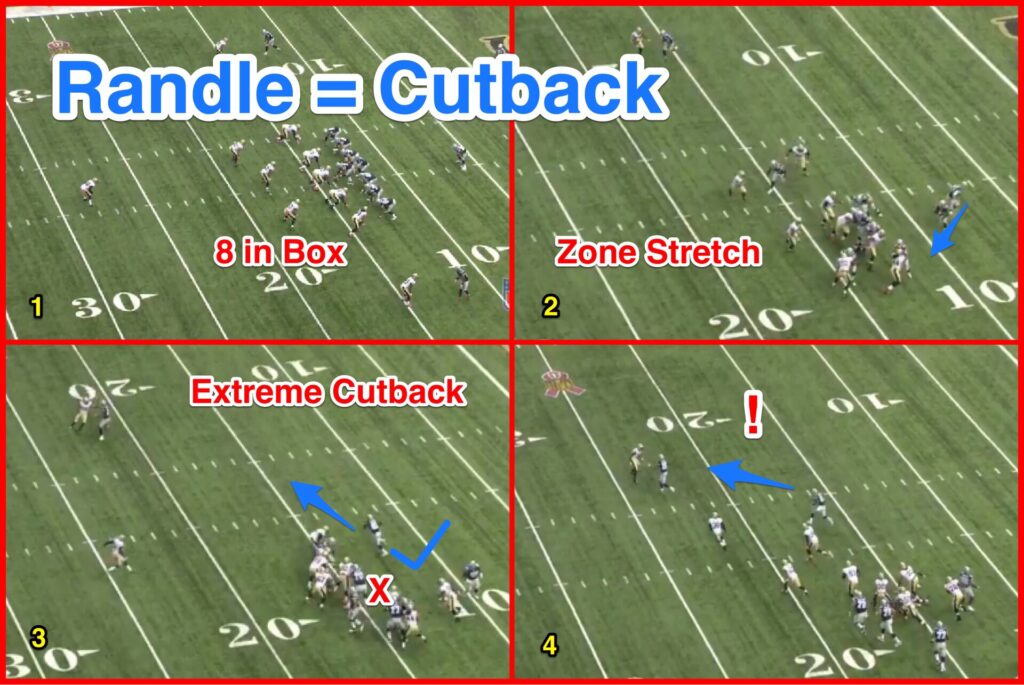
Another characteristic of Randle run is that, while technically still a cutback, it appears to be a hard downhill charge that belies its nature.
He briefly extends the play to the play-side before swiftly driving it downfield on the opposite side of the center.
This type of run exploits a defense’s inclination to react swiftly to the initial play direction without squandering valuable vertical space by looping back across the field (as depicted below).
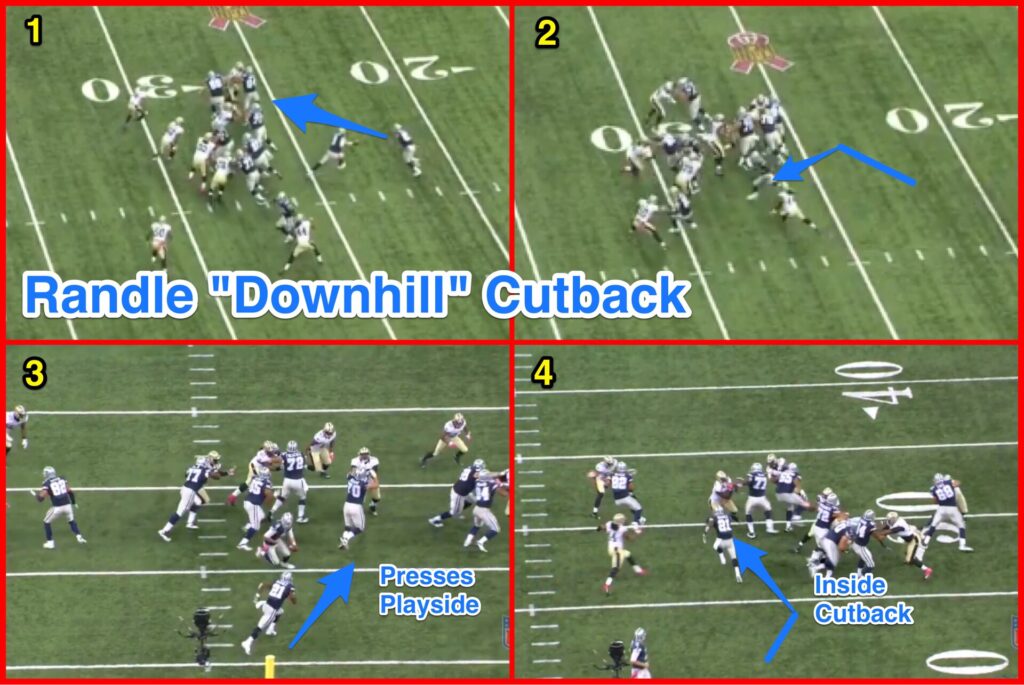
RUN DMC
The optimal approach for the Cowboys to kickstart a potent ground game early on is to unleash the explosive power of Darren McFadden, who stands as the most dynamic power back on their roster.
While he has been managed with a controlled number of repetitions in the early season, this caution is justified given his history of injuries throughout his career.
However, for one game, he represents the player with the highest likelihood of effectively executing a power-running, clock-controlling game plan.
McFadden’s most notable strength lies in his ability to burst through offensive line openings once they manifest.
He is entrusted with a more significant share of the Cowboys’ “power” scheme run plays, which involve offensive linemen pulling, as they are better suited to a straight-line, explosive runner who must patiently wait for a hole to materialize before accelerating through it, resistant to arm tackles that may attempt to impede his progress (as exemplified below).
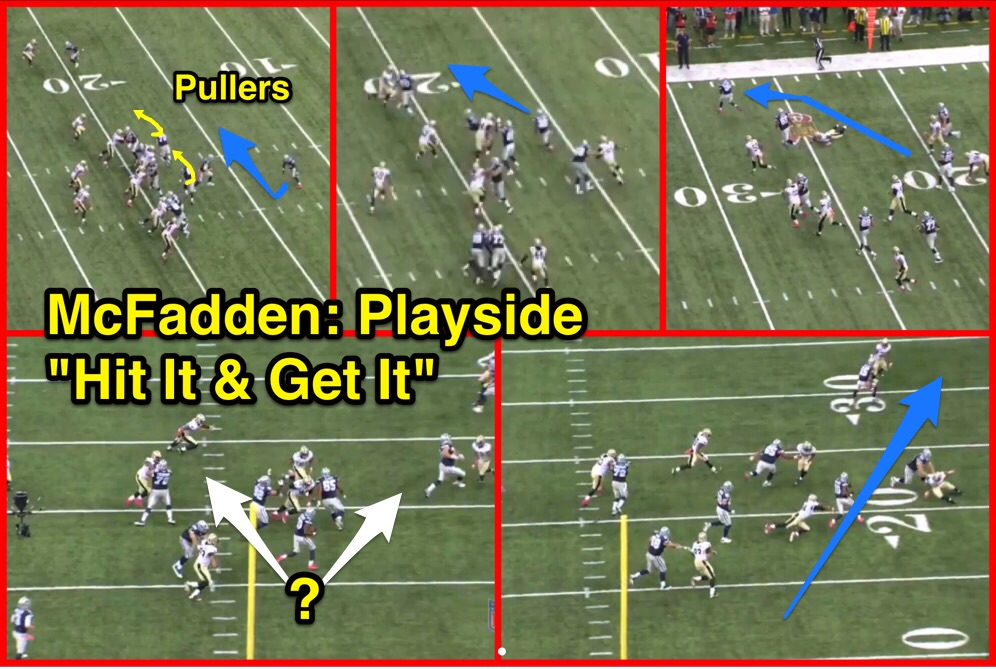
While McFadden may not possess exceptional agility in the open field, his forceful running style and the typical plays that align with his strengths are the likeliest means to draw the Patriots out of their nickel defensive formations.
Suppose the Cowboys can achieve this objective early on. In that case, there’s a promising likelihood that they can level the playing field and make this a competitive game by limiting the amount of time Tom Brady and the offense have possession of the football.
Both teams are likely considering the same strategy: The Cowboys need to establish a solid running game, and the Patriots need to prevent them from doing so. The side that falters in this aspect is likely to come up short.
While completely shutting down a Tom Brady-led offense may not be a realistic goal, effectively using your own offense to control possession and keep his unit off the field is a positive step in the right direction…

